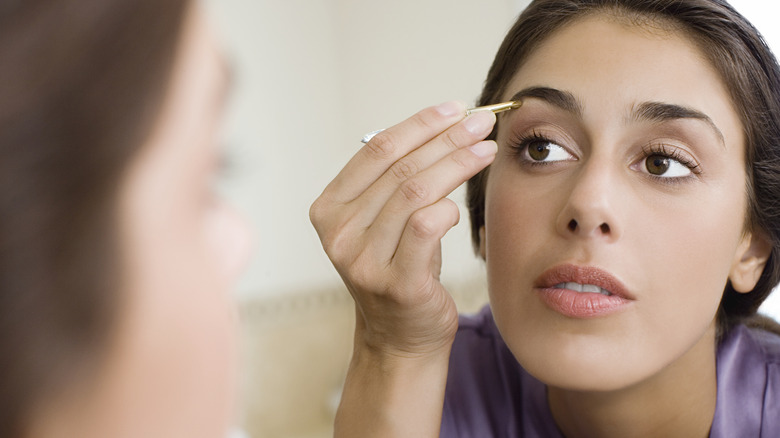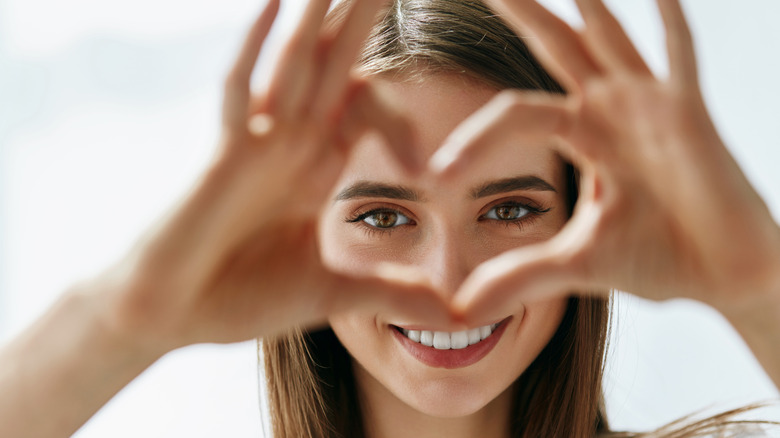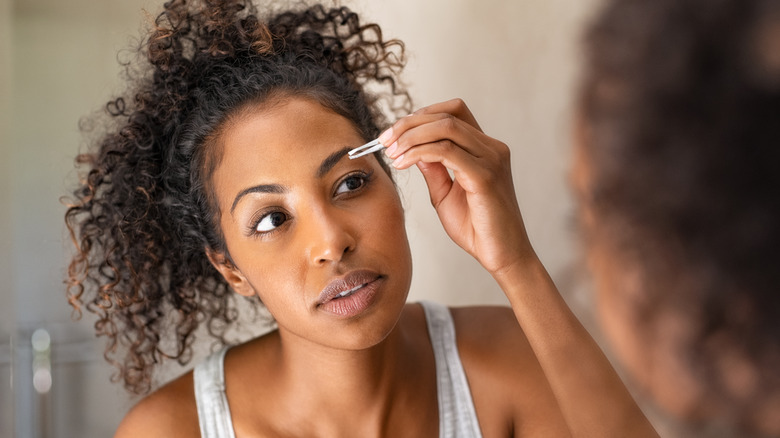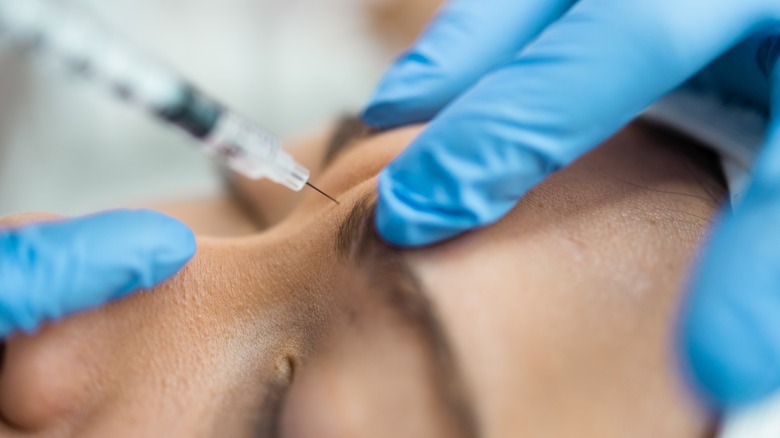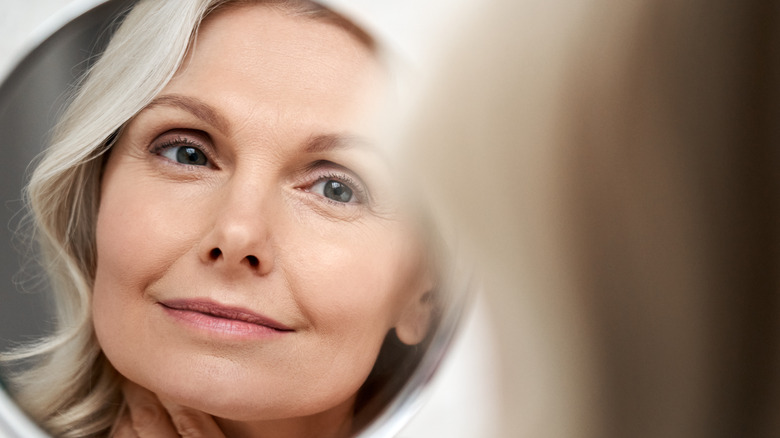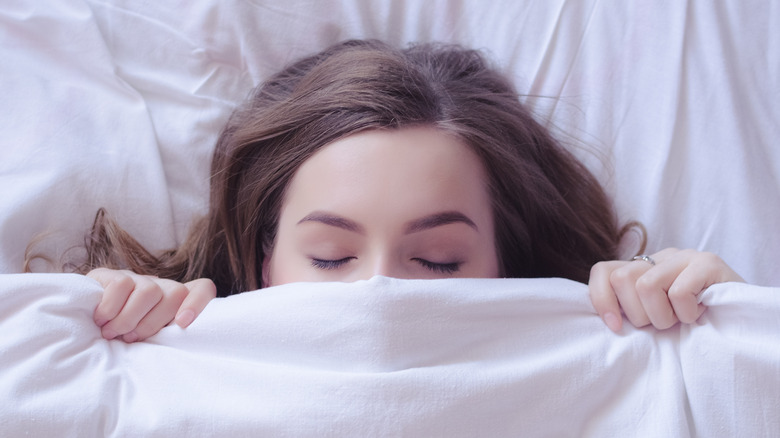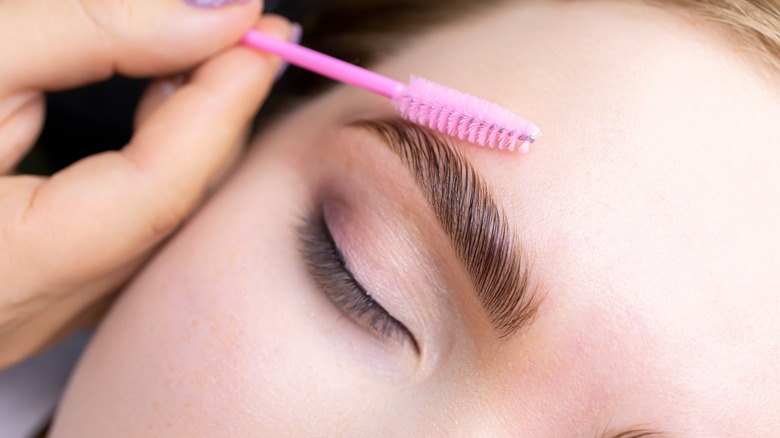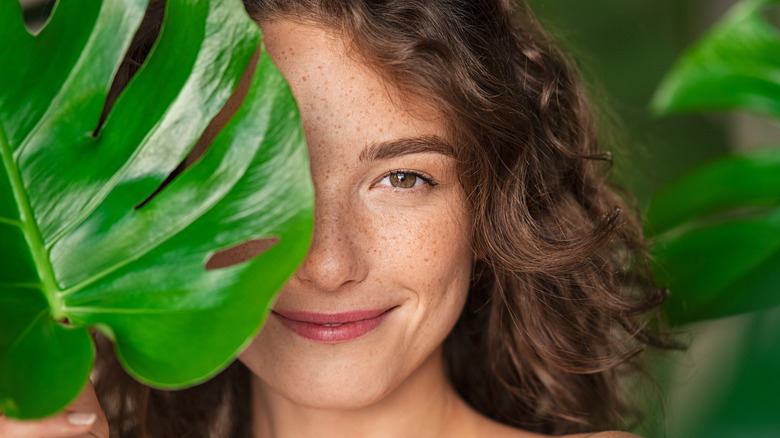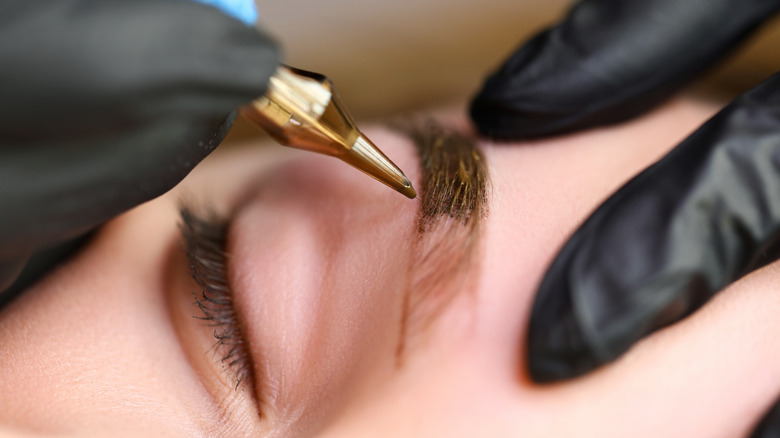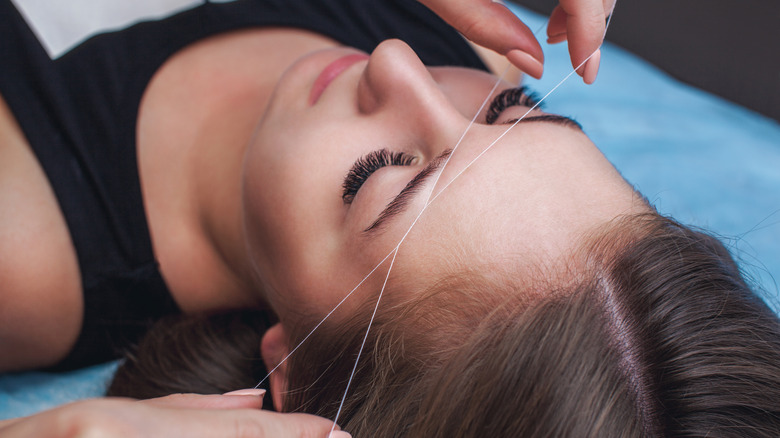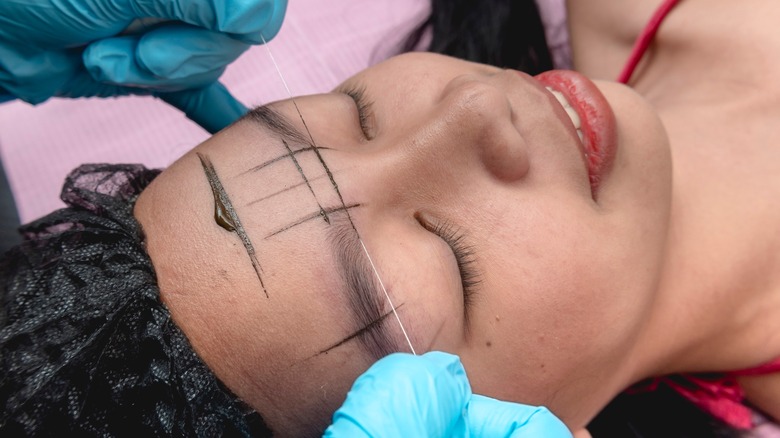Sisters, Not Twins: The Reason Behind Uneven Eyebrows
Of all the rapidly-evolving beauty trends out there, anything involving eyebrows will always be a crowd favorite. And who can blame us? Full and fluffy, '90s thin, natural, bleached, feathered, laminated ... there are countless creative ways to style your brows, and nothing can sour your makeup mood quicker than a stubborn case of unevenness. But before you reach for the tweezers (or whatever your preferred brow-grooming method may be), you might want to stop and consider the reason (or reasons) that your brows are being so unruly.
You might be surprised by the number of reasons behind uneven or patchy eyebrows — and their solutions. Causes vary from person to person, but can include anything from medical conditions and lifestyle choices to your go-to grooming method itself.
In a world where stylishly-coiffed eyebrows are a beauty must-have, it's certainly worth the deep dive to learn how to properly care for your beloved brows. Here is our breakdown of all the possible reasons behind uneven eyebrows, plus a few solutions that will have them looking their best in no time.
Your brows were born that way
Chances are, you've heard the adage before: your eyebrows are sisters, not twins. Just like no two people are exactly alike, no two pairs of eyebrows are either. Some are naturally sparser, fuller, higher, or lower – and that's perfectly okay. Social media sites like Instagram and TikTok may lead you to believe that your brows must look flawless at all times, but this is unrealistic and many studies, like one published in the "European Scientific Journal," have confirmed a negative correlation between social media use and self-esteem.
The truth is, it is incredibly rare to find a pair of eyebrows — let alone an entire face — that is naturally symmetrical. In fact, most eyebrows are naturally asymmetrical to some extent. So if you're prone to feeling insecure about your eyebrows' appearance, remember: stereotypically "perfect" eyebrows don't really exist.
That being said, it's also perfectly okay to want to change your brows' appearance. After all, there is a reason why anything involving eyebrows is consistently one of our favorite beauty trends. Just like the latest hair and makeup styles, eyebrow trends are a chance to make a statement, get creative, and have some fun with your appearance. So embrace your brows, even if they are a bit imperfect, and don't be afraid to have some fun with them.
You've fallen victim to the dangers of over-grooming
If unevenness is a relatively new problem for you, chances are that your brow grooming routine could be to blame. Over-plucking, over-waxing, and over-threading can all lead to uneven or sparse brows — and let's be honest, who hasn't unintentionally over-plucked at least once or twice in their lives? (Or maybe you were going for that '90s throwback look like Bella Hadid.)
According to the Wimpole Clinic in London, your eyebrow hairs naturally go through a four-phase growth cycle roughly every four months: from growth to transition to resting to shedding. But excessive grooming can disrupt the hairs' healthy growth cycle, leading to what may seem like chronically uneven brows. In most cases, the hairs will eventually grow back given enough time. However, it is possible to permanently damage the hair follicles through over-grooming.
Though each person's eyebrow hair growth cycle is different, it will generally take around three to four weeks for over-plucked brows to grow back in fully, provided the follicles haven't sustained any serious damage. However, this process can take a bit longer for certain people, in some cases up to four months. In the meantime, it may be worth it to invest in a good eyebrow pencil to camouflage any lopsidedness caused by over-grooming, or even look into more permanent solutions should you find that your hair isn't growing back as quickly as you would have hoped.
Blame the Botox
When it comes to fine lines and crow's feet, Botox may seem like a fast, simple, and relatively easy solution. However, every injection can affect the facial muscles differently, including the muscles that control the eyebrows. The fan-shaped muscles beneath the eyebrows (called corrugators) and particularly the muscles in the forehead (called the frontalis) are popular Botox injection sites due to the number and depth of the wrinkles that can form on the forehead as we age. According to Healthline, one common side effect of Botox injections is that one muscle can be more impacted by the procedure than others, causing the nearby eyebrows to appear uneven. In most cases, one eyebrow will appear to be higher or lower than the other.
The effects of Botox can begin to fade in a matter of days, weeks, or months depending on the location of the injections and the dosage used. Board-certified plastic surgeon Dr. Cynthia Poulos states in her blog that Botox injections administered in the forehead can take up to four months to fade.
If you suspect Botox might be to blame for any recent unevenness in your brows, your best bet will ultimately be to wait and allow the drug to fade. Though four months may seem like a long time, you will eventually regain mobility in the affected muscle, as well as regain your eyebrows' natural appearance.
It could simply be a matter of age
Everything about our bodies changes as we age, and that includes our eyebrows. Over time, it is completely normal for brows to thin, change color, and even shift positions due to a lack of muscle tone and skin elasticity, per a study published in the "International Open Access Journal of the American Society of Plastic Surgeons." Aging can cause both the front and tail of our brows to recede, which shortens their overall appearance, and can also cause a reduction in our bodies natural production of lubricating oils, thus making eyebrow hairs appear coarser and become more difficult to groom. Women, in particular, may find that their eyebrows begin to change as they age due to the hormonal changes associated with menopause.
But primarily, the effects of aging that we associate with our eyebrows can be blamed on the skin's natural aging process. As skin loses its elasticity, hair follicles become brittle and can shrink, leading them to ultimately stop producing hair altogether. There are some more drastic solutions out there — eyebrow hair transplants are on the rise and the procedure is increasingly popular in celebrity circles. But the simplest, quickest, and most cost-effective solution for aged eyebrows remains to camouflage sparseness with makeup.
Rethink your sleep position
Believe it or not, studies, like one published in the journal "Ophthalmic Plastic and Reconstructive Surgery," have found that sleep position can actually have an effect on the symmetry — or lack thereof — of both eyebrows and eyelids. Side-sleepers are particularly prone to this effect; consistently sleeping on one side or the other has been found to cause an imbalance in muscle tone on either side of the face. One possible result of this muscle imbalance is unevenness in the eyebrows, with one eyebrow commonly appearing to be higher or lower than the other.
Furthermore, the friction between your skin, eyebrows, and the pillowcase can cause brow hairs to shed faster, especially in the tail of the brow. A faster rate of shedding means thinner-looking brows, and can sometimes even lead to patchiness. But, this isn't a major problem for everyone; those with naturally strong eyebrow hairs or naturally deep roots often don't have this friction issue.
Even if you aren't blessed with naturally well-rooted eyebrow hairs, there are ways to strengthen them, both through diet and an array of serums that promise healthier and more robust brows. If you're unwilling to make the change from side-sleeper to back-sleeper, consider switching to a satin or silk pillowcase, which will lessen the amount of friction your eyebrows have to endure on a nightly basis.
There might be a medical cause
If you've ruled out all other reasons, it might be time to take the matter to your doctor. According to the Wimpole Clinic, many medical conditions can cause thinning and unevenness of the eyebrows, including eyebrow alopecia, autoimmune disorders such as lupus, thyroid imbalances, or even just side effects of different medications. Retinol, which is available in both over-the-counter and prescription strengths to treat a myriad of different skin problems, has also been found to contribute to eyebrow hair loss.
Speaking with a medical professional who is familiar with your health history is key. Your doctor might conclude that the problem is something as simple as a less-than-healthy diet. After all, when your body perceives that there are not enough nutrients and calories to go around, it can slow or even shut down non-essential functions like hair growth. They may propose a solution as simple as incorporating a new supplement into your diet, or suggest tweaking your diet itself.
Chronic stress, certain medications, and hormone imbalances can also cause changes to your eyebrows' appearance. Your doctor can change or prescribe new medications to address the issue at hand, rule out other causes using tests, and generally put your mind at ease as to what may be causing your eyebrows to thin or change.
You're not giving the sisters patience (or any TLC)
Unfortunately, the only real solution to the problem of over-plucked brows is time. And given that their natural growth cycle takes around four months to complete, you could end up waiting that long for your brows to grow back in. Though it may be tempting, try to resist the urge to groom your eyebrows in the meantime, aside from the occasional light clean-up. However, if your patience is already wearing thin, there are several promising ways to encourage faster growth and give your brows the tender love and care that they deserve.
With brow serums becoming an ever more popular beauty staple, it might be worth incorporating one into your regular beauty regimen. Many serums contain ingredients such as peptides, antioxidants, amino acids, and other natural extracts that can help strengthen and thicken brows with regular application. According to the Cleveland Clinic's Health Essentials blog, there are even over-the-counter supplements that can promote faster growth and healthier brows, such as biotin, iron, and omega-3. However, remember to always consult your doctor before starting a new supplement, as some supplements can negatively interact with certain medications and conditions. Your doctor might even recommend a topical hair growth product, whether prescription or over-the-counter, many of which have been found to promote hair growth on the eyebrows as well as the scalp.
Now that you know the possible causes of uneven brows, here's how you can remedy them.
Camouflage with makeup
The good news, if you happen to be self-conscious about the appearance of your uneven brows, is that there are tons of fun and effective ways to use makeup in order to give yourself the look that you want. Understandably, the sheer number of brow products on the market can be overwhelming, but most of them fall into three categories: brow gels, powders, and pencils. What's the difference? Gels help to hold the brows in place and add fullness. They come in handy for shaping and for keeping curly or otherwise unruly hairs in check. Powders are a bit more subtle, and are typically applied with an angled brush. They have a soft, matte finish and can be used to both fill in sparse areas and build up your arch. in fact, powders are especially great for achieving the ombré brow trend.
And then there are pencils. A classic eyebrow beauty must-have, pencils are all about precision. They can be used to fill in gaps as well as define the entire shape of the brow. Thinner pencils can be used to create fine, hair-like strokes while wider pencils can fill in larger areas and scars.
Beyond the magic of gels, powders, and pencils, there are still plenty of other products if you're feeling adventurous. Brow mousses, pomades, and tints are just a few other easy-to-find products. You can even DIY your go-to brow style using a spoolie with Vaseline or hairspray. The options really are endless.
Explore more permanent solutions
For those with very thin or sparse brows (or even no brow hair at all), there is a range of more permanent, or semi-permanent, options out there. Among the most popular procedures are the similarly-named microblading and microshading. Even though the procedures sound nearly the same, Healthline outlines the differences: Microblading uses a bladed needle to apply pigment underneath the skin like a tattoo; the pigment is typically applied in small, hair-like strokes, resulting in an appearance similar to natural brows. Microshading, on the other hand, uses a needle to apply small dots of pigment under the skin, mimicking the subtle appearance of a brow powder.
Both microblading and microshading are considered semi-permanent, with results lasting anywhere from three months up to three years depending on the person receiving the treatment and the technician who performs it. It is also recommended to return to your favorite beauty tech every six to eight months for a touch-up to keep your bladed or shaded brows looking their best.
Both procedures usually require two sessions lasting one to two hours. During your first session, you'll be able to choose the shape and color you prefer, and afterward, you'll receive advice on how to make your results last as long as possible.
Groom responsibly going forward
Not every brow grooming method is easy to achieve at home, at least not without substantial experience, but that isn't to say that you can't DIY a stunning pair of eyebrows. Still, whether your preference is tweezing, waxing, or threading, it's definitely worth visiting a professional to get their advice on what hair-removal methods are best for your skin and brows. They can also tell you how to maintain your preferred look in the future.
Tweezing also happens to be the most at-home-friendly method of brow grooming, allowing you to control the direction in which you remove each individual hair and keep breakage to a minimum. However, when tweezing, remember that precision is power; don't abuse it, or you'll end up harming your brows or even your hair follicles by over-plucking.
Unless you happen to be an expert, waxing and threading are usually best left to the professionals, as it is far easier to slip up and take out entire clumps of hair at a time if you attempt to DIY it. Remember, one poorly placed wax strip could cost you up to four months' worth of waiting for the hair to grow back.
Research shapes and styles to best suit your face
If you're considering trying out a certain eyebrow trend, or just want to shake up your look, but are already worried that your brows might not be up to the challenge, it could be helpful to get ahead of the game and do some research on what shape or style would best suit your face and the look you're going for. As a rule of thumb, higher arches and sharper angles can help to even out the soft curves of round or oval faces, while straight brows can soften and even appear to shorten a long or square face.
You might even consider taking a deep dive into eyebrow mapping, a practice that uses measurements to determine your ideal brow shape. Many eyebrow connoisseurs swear by the process, which promises to help achieve more symmetrical brows that compliment all your facial features. Most, if not all, professionals already use some degree of brow mapping in order to help themselves and their client to get on the same page and achieve the desired look.
